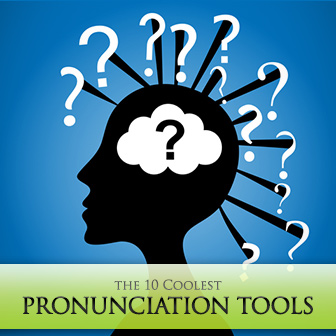How Do You Say That? The 10 Coolest Pronunciation Tools for ESL Students


But it is also our responsibility to coach them in better ways to study and practice on their own. In other articles, I list The 10 Coolest Pronunciation Tools for ESL Students, five mobile apps and five websites that are ideal for self-study. But the wealth of resources does not end there. Here are some online resources that every ESL student – and teacher – should access for reference and continued pronunciation practice.

This Canadian college offers a comprehensive practice guide to English pronunciation, divided into 13 units. Each unit focuses on a particular sound or set of sounds and is packed with activities to help students practice them including video, audio and dictation. Students have the option to record their voice in a conversation. Of particular use to teachers are the workbooks available for each unit – available in MP3 audio, too!
The University of Iowa offers an amazing flash interactive guide to American English pronunciation. It is a complete guide to phonetics, presented in a clear, concise manner that even ESL students should be able to grasp. A series of buttons help students navigate the different aspects of vowel and consonant sounds, which are demonstrated with animation with sound and video.
The website provides a great guide to how to pronounce different sounds in English. The sounds are presented in contrasting pairs (like heat and hit); click on each and you have access to a description of how each sound is produced, plus video and audio files for each. And there’s a bonus for ESL teachers – a “Tips for Teachers” section with some fabulous ideas for pronunciation activities.
San Jose City College has an excellent ESL department, which in addition to its regular course, provides and online lab called ESL Station. It offers interactive pronunciation activities that include Syllables and Stress Patterns, Stress Patterns in Words and Rhythmic Patterns. It also has a very complete pronunciation guide with listening exercises and quizzes.
ManyThings.org has an American English Pronunciation Practice page specifically designed for ESL students. It offers great minimal pair practice with Flash and MP3 audio. The site also features “Listen and Repeat” videos that are really useful for students to practice pronunciation at home.
SpokenSkills is a site that has tons of resources for the ESL student and teacher, but in terms of pronunciation practice, be sure to check out the exercises for vowel and consonant sounds. For each sound, there are lists of practice phrases that students can hear. They may also record their own voice and repeat the process till they are satisfied with the results. There are also intonation exercises and minimal pairs for practice.
Merriam-Webster’s Learner’s Dictionary has Perfect Pronunciation practice exercises, including 15 sessions in all, each featuring a different set of sounds and five exercises for each. Students first listen to a set of words with the same sound, then listen again and repeat each one. Finally, there’s a quiz to test a student’s ability to recognize different sounds. There are also exercises for syllable stress and those labeled as sentence practice, review everything learned during the session.
And just when you thought there weren’t any resources for young learners to practice pronunciation with, here comes the BBC with their Words and Pictures site. Through a variety of fun, interactive games, little ones can practice consonant and vowel sounds, as well as CVC words. Probably the best way to introduce young ESL learners to phonemes.
Also great for young learners, the Sound-O-Matic lets them choose different vowel-consonant combinations like –as, –an, –ap,–at, etc… and explore the different words than can be made with these combinations.
This can only mean good news for ESL teachers as we have access to more resources and not just simple lists or exercises to copy. We have access to technology that can put ESL students in the driver’s seat and really take charge of their self-study time.
Have you tried any of these websites with your students? If you have any others to recommend, be sure to do so below!